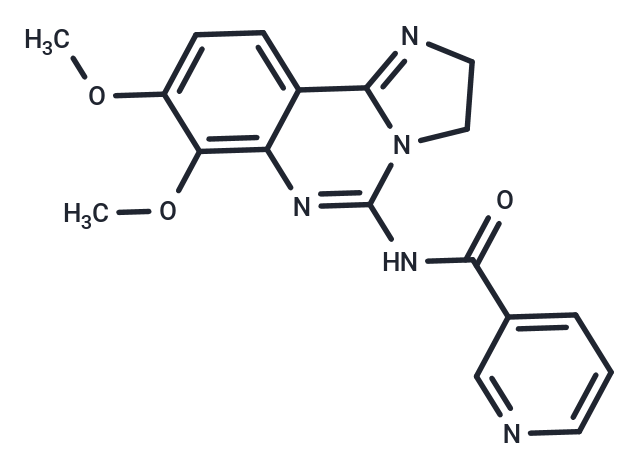Shopping Cart
- Remove All
 Your shopping cart is currently empty
Your shopping cart is currently empty

PIK-90, a DNA-PK and PI3K inhibitor, suppresses p110α( IC50=11 nM), p110γ(IC50=18 nM) and DNA-PK(IC50=13 nM) .

| Pack Size | Price | Availability | Quantity |
|---|---|---|---|
| 5 mg | $39 | In Stock | |
| 10 mg | $47 | In Stock | |
| 25 mg | $85 | In Stock | |
| 50 mg | $147 | In Stock |
| Description | PIK-90, a DNA-PK and PI3K inhibitor, suppresses p110α( IC50=11 nM), p110γ(IC50=18 nM) and DNA-PK(IC50=13 nM) . |
| Targets&IC50 | PI3Kα:11 nM, DNA-PK:13 nM, PI3Kγ:18 nM |
| In vitro | In insulin-stimulated animals, treatment with PIK-90 (10 mg/kg) is capable of inhibiting the reduction of blood glucose levels induced by insulin stimulation. |
| In vivo | In chronic lymphocytic leukemia cells, treatment with PIK-90 (1-10 μM) suppresses chemotaxis, significantly inhibiting cell migration into the stromal cell layer and reducing CXCL12-induced actin polymerization. In dHL60 cells, PIK-90 inhibits Akt phosphorylation stimulated by fMLP, impairing cell polarity and chemotaxis. Moreover, in glioma cell lines (U87 MG, SF188, SF763, LN229, A1207, and LN-Z30 cells), PIK-90 blocks Akt phosphorylation, inhibiting cell proliferation. |
| Kinase Assay | Expression and Assay of p110α/p85α, p110β/p85α, p110δ/p85α, and p110γ : IC50 values are measured using either a standard TLC assay for lipid kinase activity or a high-throughput membrane capture assay. Kinase reactions are performed by preparing a reaction mixture containing kinase, inhibitor (2% DMSO final concentration), buffer (25 mM HEPES, pH 7.4, 10 mM MgCl2), and freshly sonicated phosphatidylinositol (100 μg/mL). Reactions are initiated by the addition of ATP containing 10 μCi of γ-32P-ATP to a final concentration 10 μM or 100 μM, and allowed to proceed for 20 minutes at room temperature. For TLC analysis, reactions are then terminated by the addition of 105 μL 1N HCl followed by 160 μL CHCl3:MeOH (1:1). The biphasic mixture is vortexed, briefly centrifuged, and the organic phase transferred to a new tube using a gel loading pipette tip precoated with CHCl3. This extract is spotted on TLC plates and developed for 3-4 hours in a 65:35 solution of n-propanol:1M acetic acid. The TLC plates are then dried, exposed to a phosphorimager screen, and quantitated. For each compound, kinase activity is typically measured at 10-12 inhibitor concentrations representing two-fold dilutions from the highest concentration tested (100 μM). For compounds showing significant activity, IC50 determinations are repeated two to four times, and the reported value is the average of these independent measurements. |
| Cell Research | For viabilty, cells are seeded in 12-well plates in the presence of PIK-90 for 3 days. Cell viability is determined using a WST-1 assay.(Only for Reference) |
| Molecular Weight | 351.36 |
| Formula | C18H17N5O3 |
| Cas No. | 677338-12-4 |
| Smiles | COc1ccc2C3=NCCN3C(NC(=O)c3cccnc3)=Nc2c1OC |
| Relative Density. | 1.42 g/cm3 (Predicted) |
| Storage | Powder: -20°C for 3 years | In solvent: -80°C for 1 year | Shipping with blue ice. |
| Solubility Information | Ethanol: < 0.2 mg/mL (insoluble or slightly soluble) DMSO: < 0.2 mg/mL (insoluble or slightly soluble), Sonication is recommended. H2O: < 0.2 mg/mL (insoluble or slightly soluble) |

Copyright © 2015-2025 TargetMol Chemicals Inc. All Rights Reserved.